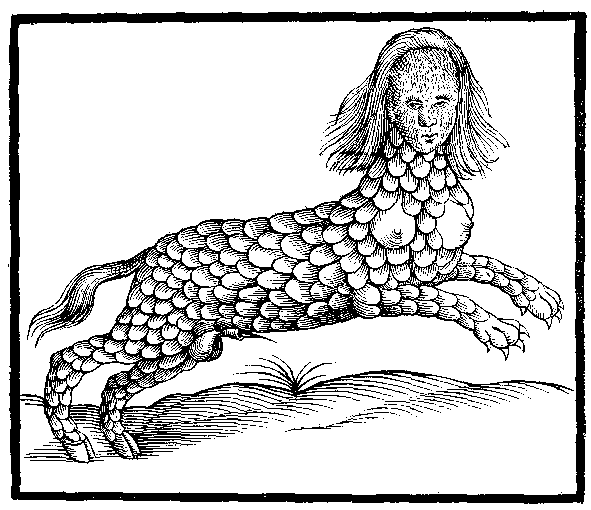

According to Politianus’s preface to Aristotle’s first book of ‘Old Wives Analyticks’, ‘there were certain Lamiae in the wilderness, which like Bug-bears would eat up crying boys, and that there was a Well near to Fesulanum, being very bright, yet in continual shadow, never seeing Sun, where these Phairy women have their habitation.’
Plutarch notes that ‘they have exemptile eyes... and that as often as they go from home, they put in their eyes... you will think... that they have the eyes of Kites, for there is no small thing but they espy it’ However, when the Lamiae return home, ‘they pull out their eyes, and cast them aside, so being blinde at home, but seeing abroad.’ This ‘removable eyes’ theory, along with the other equally bizarre tales about the Lamia, seems to have been enough to convince Topsel that he was dealing with something which, if not unreal, was at least un-Godly. ‘These and other such stories and opinions... in my judgement arise from the prestigious apparitions of Devils’. It should probably be recorded that Topsel was, by turns, a minister, a vicar, a rector and finally a curate, and his first book was titled in part ‘The Reward of Religion’.
Topsel gives no indication that he considers the Manticore to be an imaginary beast, which is hard to explain, given his reticence about some other fantastical creatures. ‘This beast or rather Monster... is bred among the Indians, having a treble row of teeth beneath and above, whose greatness, roughness, and feet are like a Lyons, his face and ears unto like a mans; his eyes gray, his colour red, his tail like the tail of a Scorpion, of the earth, armed with a sting, casting forth sharp pointed quils’
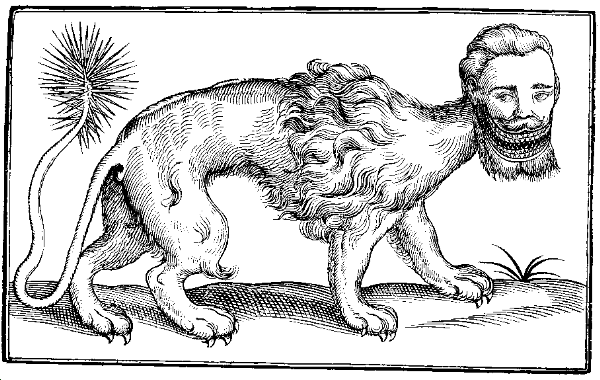
The Manticore’s mouth reaches ‘both sides to its ears’
(Terry Gilliam, where were you in 1607...?)
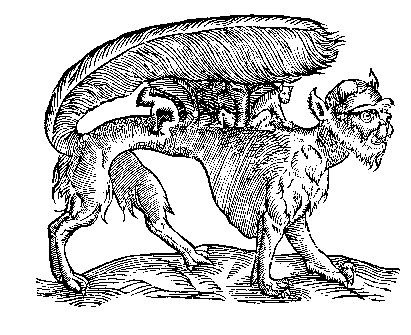
The Su is ‘a Wilde Beast (of) the New-found World’; specifically of a region called Gigantes, which appears to correspond to Patagonia, or southern Peru. It is of ‘a very deformed shape, and monstrous presence, a great ravener and untameable wilde Beast’. It is ‘cruel, untameable, impatient, violent, ravening and bloudy’, and devours its own young rather than let them be taken by hunters. As the Su seems to be some sort of monkey, these descriptions seem a little hyperbolic, but Topsel admits that he can find little ‘recorded of this most savage Beast.’
Because of the Unicorn’s ‘rare vertues’, its authenticity seems to be of considerable importance to Topsel, and he sets out immediately to use ‘some diligence in comparing together the several testimonies that are spoken’ of it. However, as one of these testimonies originates in The Bible (Psalm 92), the result is something of a forgone conclusion. What Topsel is particularly interested in is the Unicorn’s horn, which is invested with all sorts of magical and medicinal properties. Topsel cites numerous people, including a personal friend, who claim to have seen and handled a Unicorn’s horn. There was, for instance, such a horn found in 1520, in the river Arrula, and which was taken to the Govenor of Helvetia. It was ‘very odoriferous (especially when any part of it was set on fire)’. A friend of Gesner’s (Topsel’s main source) also claims to have held a Unicorn horn, which was ‘the length of a tall man’. Unicorn’s horns, it seems, are rather more easy to come by than the rest of the animal, which is perhaps another reason why Topsel dwells on the horn issue.
Unicorns, as is well known, ‘reverence Virgins and young Maids’. ‘They keep for the most part in the Deserts, and live solitary in the tops of Mountains.’. Topsel also notes that ‘‘their legs have no Articles.’
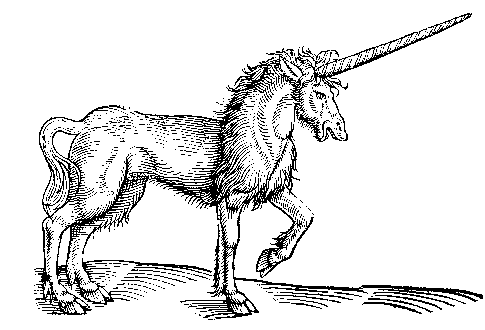
Unlike Reindeer, Unicorns do not sound like cracking nuts when they walk.
Some of the oddest beasts in medieval bestiaries abide in the oceans. Compared with, for example, The Bishop-Fish, the Sea-Wolf is relatively mundane. It looks rather like a North American Cat of some sort to me, but this conflicts with Topsel’s description of it as a beast ‘of the ancient writers’, which ‘hath been seen upon the Britain Ocean shoar’. Other than that, Topsel has nothing much to offer by way of information on the Sea-wolf, except this illustration.
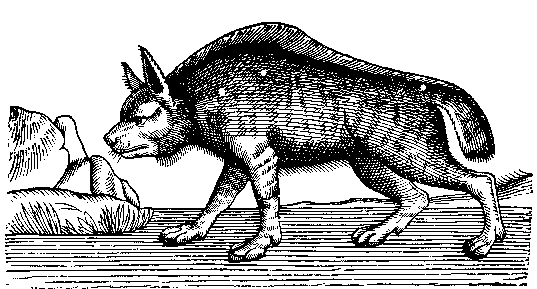
Camelopardals are ‘very tractable and easie to be handled, so that a child may lead them with a small line of cord about their head’.
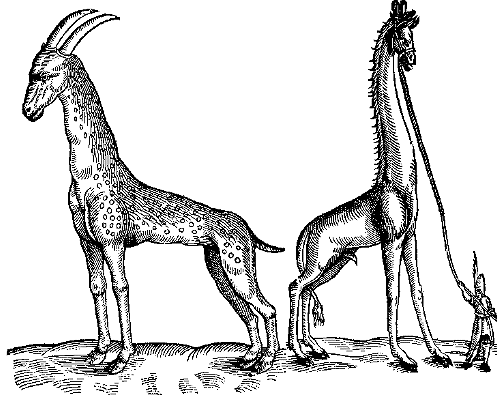
There are two types of Camelopardals
‘The head thereof is like to a Camels, the neck to a Horses, the body to a Harts; and his cloven hoof is the same as a Camels: the colour of this Beast is for the most part red and white, mixed together, therefore very beautiful to behold, by reason of the variable and interchangeable skin, being full of spots; but yet they are not always of one colour. He hath two little horns growing on his head of the colour of iron, his eyes rowling and frowing, his mouth but small like a Harts, his tongue is neer three foot long, and with that he will so speedily gather in his meat, that the eyes of a man will fail to behold his hast, and his neck diversly coloured is fifteen feet long.’
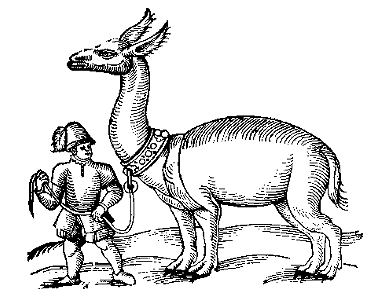
Though Topsel speculates that the Allocamelus is the hybrid offspring of a mule and camel, its one and only appearance in his sources makes it plain that the real beast is a Llama. The picture of the Allocamelus seen below was found in a description dated 1558. It was taken ‘out of the region of Peru, and so was brought to Antwerp, six thousand miles distant from that nation.’
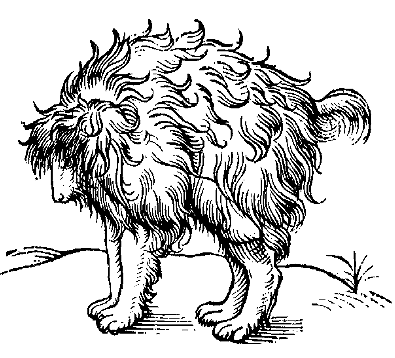
I have an irrational fondness for the Mimick
The Mimick is a type of Dog which, according to Topsel is thought by some 'to be conceived by an Ape; for in wit and disposition it resembleth an Ape'. The Mimick is able 'to imitate all things it seeth'. Plutarch reported that he saw a public spectacle before the emperor in Rome, wherein a Mimick enacted an entire dramatic production containing 'many persons parts', including a death scene, during which 'he began to reel and stagger to and fro like a drunken man'.
And here, for the time being, endeth my website on the Historie of Four-footed Beafts.
Text c. 1998, Tim Gadd
| Topsel main page | |
| 1. Common Beasts | 2. Exotic Beasts |